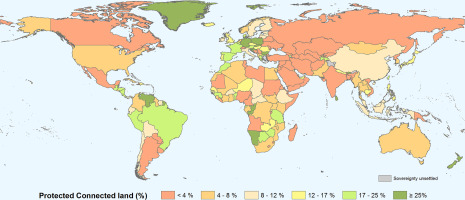当前位置:
X-MOL 学术
›
Biol. Conserv.
›
论文详情
Our official English website, www.x-mol.net, welcomes your feedback! (Note: you will need to create a separate account there.)
Protected area connectivity: Shortfalls in global targets and country-level priorities
Biological Conservation ( IF 5.9 ) Pub Date : 2018-03-01 , DOI: 10.1016/j.biocon.2017.12.020 Santiago Saura , Bastian Bertzky , Lucy Bastin , Luca Battistella , Andrea Mandrici , Grégoire Dubois
Biological Conservation ( IF 5.9 ) Pub Date : 2018-03-01 , DOI: 10.1016/j.biocon.2017.12.020 Santiago Saura , Bastian Bertzky , Lucy Bastin , Luca Battistella , Andrea Mandrici , Grégoire Dubois

|
Connectivity of protected areas (PAs) is crucial for meeting their conservation goals. We provide the first global evaluation of countries' progress towards Aichi Target 11 of the Convention on Biological Diversity that is to have at least 17% of the land covered by well-connected PA systems by 2020. We quantify how well the terrestrial PA systems of countries are designed to promote connectivity, using the Protected Connected (ProtConn) indicator. We refine ProtConn to focus on the part of PA connectivity that is in the power of a country to influence, i.e. not penalizing countries for PA isolation due to the sea and to foreign lands. We found that globally only 7.5% of the area of the countries is covered by protected connected lands, which is about half of the global PA coverage of 14.7%, and that only 30% of the countries currently meet the Aichi Target 11 connectivity element. These findings suggest the need for considerable efforts to improve PA connectivity globally. We further identify the main priorities for improving or sustaining PA connectivity in each country: general increase of PA coverage, targeted designation of PAs in strategic locations for connectivity, ensuring permeability of the unprotected landscapes between PAs, coordinated management of neighbouring PAs within the country, and/or transnational coordination with PAs in other countries. Our assessment provides a key contribution to evaluate progress towards global PA connectivity targets and to highlight important strengths and weaknesses of the design of PA systems for connectivity in the world's countries and regions.
中文翻译:

保护区连通性:全球目标和国家级优先事项的不足
保护区 (PA) 的连通性对于实现其保护目标至关重要。我们首次对各国在实现《生物多样性公约》爱知目标 11 的进展情况进行全球评估,该目标是到 2020 年至少有 17% 的土地被连接良好的 PA 系统覆盖。我们量化了国家旨在使用受保护的连接 (ProtConn) 指标来促进连接。我们改进了 ProtConn 以专注于一个国家有权影响的 PA 连接部分,即不惩罚由于海洋和外国土地而导致 PA 隔离的国家。我们发现,全球只有 7.5% 的国家被保护连接的土地覆盖,这大约是全球 PA 覆盖率 14.7% 的一半,目前只有 30% 的国家满足爱知目标 11 的连通性要素。这些发现表明需要付出相当大的努力来改善全球 PA 的连通性。我们进一步确定了改善或维持每个国家保护区连通性的主要优先事项:普遍增加保护区覆盖率,有针对性地指定战略位置的保护区以实现连通性,确保保护区之间未受保护景观的渗透性,协调管理国内邻近保护区,和/或与其他国家的保护区的跨国协调。我们的评估为评估实现全球 PA 连通性目标的进展以及突出世界国家和地区连通性 PA 系统设计的重要优势和弱点做出了重要贡献。这些发现表明需要付出相当大的努力来改善全球 PA 的连通性。我们进一步确定了改善或维持每个国家保护区连通性的主要优先事项:普遍增加保护区覆盖率,有针对性地指定战略位置的保护区以实现连通性,确保保护区之间未受保护景观的渗透性,协调管理国内相邻保护区,和/或与其他国家的保护区的跨国协调。我们的评估为评估实现全球 PA 连通性目标的进展以及突出世界国家和地区连通性 PA 系统设计的重要优势和弱点做出了重要贡献。这些发现表明需要付出相当大的努力来改善全球 PA 的连通性。我们进一步确定了改善或维持每个国家保护区连通性的主要优先事项:普遍增加保护区覆盖率,有针对性地指定战略位置的保护区以实现连通性,确保保护区之间未受保护景观的渗透性,协调管理国内邻近保护区,和/或与其他国家的保护区的跨国协调。我们的评估为评估实现全球 PA 连通性目标的进展以及突出世界国家和地区连通性 PA 系统设计的重要优势和弱点做出了重要贡献。我们进一步确定了改善或维持每个国家保护区连通性的主要优先事项:普遍增加保护区覆盖率,有针对性地指定战略位置的保护区以实现连通性,确保保护区之间未受保护景观的渗透性,协调管理国内相邻保护区,和/或与其他国家的保护区的跨国协调。我们的评估为评估实现全球 PA 连通性目标的进展以及突出世界国家和地区连通性 PA 系统设计的重要优势和弱点做出了重要贡献。我们进一步确定了改善或维持每个国家保护区连通性的主要优先事项:普遍增加保护区覆盖率,有针对性地指定战略位置的保护区以实现连通性,确保保护区之间未受保护景观的渗透性,协调管理国内相邻保护区,和/或与其他国家的保护区的跨国协调。我们的评估为评估实现全球 PA 连通性目标的进展以及突出世界国家和地区连通性 PA 系统设计的重要优势和弱点做出了重要贡献。确保保护区之间未受保护景观的渗透性,对国内相邻保护区的协调管理,和/或与其他国家保护区的跨国协调。我们的评估为评估实现全球 PA 连通性目标的进展以及突出世界国家和地区连通性 PA 系统设计的重要优势和弱点做出了重要贡献。确保保护区之间未受保护景观的渗透性,对国内相邻保护区的协调管理,和/或与其他国家保护区的跨国协调。我们的评估为评估实现全球 PA 连通性目标的进展以及突出世界国家和地区连通性 PA 系统设计的重要优势和弱点做出了重要贡献。
更新日期:2018-03-01
中文翻译:

保护区连通性:全球目标和国家级优先事项的不足
保护区 (PA) 的连通性对于实现其保护目标至关重要。我们首次对各国在实现《生物多样性公约》爱知目标 11 的进展情况进行全球评估,该目标是到 2020 年至少有 17% 的土地被连接良好的 PA 系统覆盖。我们量化了国家旨在使用受保护的连接 (ProtConn) 指标来促进连接。我们改进了 ProtConn 以专注于一个国家有权影响的 PA 连接部分,即不惩罚由于海洋和外国土地而导致 PA 隔离的国家。我们发现,全球只有 7.5% 的国家被保护连接的土地覆盖,这大约是全球 PA 覆盖率 14.7% 的一半,目前只有 30% 的国家满足爱知目标 11 的连通性要素。这些发现表明需要付出相当大的努力来改善全球 PA 的连通性。我们进一步确定了改善或维持每个国家保护区连通性的主要优先事项:普遍增加保护区覆盖率,有针对性地指定战略位置的保护区以实现连通性,确保保护区之间未受保护景观的渗透性,协调管理国内邻近保护区,和/或与其他国家的保护区的跨国协调。我们的评估为评估实现全球 PA 连通性目标的进展以及突出世界国家和地区连通性 PA 系统设计的重要优势和弱点做出了重要贡献。这些发现表明需要付出相当大的努力来改善全球 PA 的连通性。我们进一步确定了改善或维持每个国家保护区连通性的主要优先事项:普遍增加保护区覆盖率,有针对性地指定战略位置的保护区以实现连通性,确保保护区之间未受保护景观的渗透性,协调管理国内相邻保护区,和/或与其他国家的保护区的跨国协调。我们的评估为评估实现全球 PA 连通性目标的进展以及突出世界国家和地区连通性 PA 系统设计的重要优势和弱点做出了重要贡献。这些发现表明需要付出相当大的努力来改善全球 PA 的连通性。我们进一步确定了改善或维持每个国家保护区连通性的主要优先事项:普遍增加保护区覆盖率,有针对性地指定战略位置的保护区以实现连通性,确保保护区之间未受保护景观的渗透性,协调管理国内邻近保护区,和/或与其他国家的保护区的跨国协调。我们的评估为评估实现全球 PA 连通性目标的进展以及突出世界国家和地区连通性 PA 系统设计的重要优势和弱点做出了重要贡献。我们进一步确定了改善或维持每个国家保护区连通性的主要优先事项:普遍增加保护区覆盖率,有针对性地指定战略位置的保护区以实现连通性,确保保护区之间未受保护景观的渗透性,协调管理国内相邻保护区,和/或与其他国家的保护区的跨国协调。我们的评估为评估实现全球 PA 连通性目标的进展以及突出世界国家和地区连通性 PA 系统设计的重要优势和弱点做出了重要贡献。我们进一步确定了改善或维持每个国家保护区连通性的主要优先事项:普遍增加保护区覆盖率,有针对性地指定战略位置的保护区以实现连通性,确保保护区之间未受保护景观的渗透性,协调管理国内相邻保护区,和/或与其他国家的保护区的跨国协调。我们的评估为评估实现全球 PA 连通性目标的进展以及突出世界国家和地区连通性 PA 系统设计的重要优势和弱点做出了重要贡献。确保保护区之间未受保护景观的渗透性,对国内相邻保护区的协调管理,和/或与其他国家保护区的跨国协调。我们的评估为评估实现全球 PA 连通性目标的进展以及突出世界国家和地区连通性 PA 系统设计的重要优势和弱点做出了重要贡献。确保保护区之间未受保护景观的渗透性,对国内相邻保护区的协调管理,和/或与其他国家保护区的跨国协调。我们的评估为评估实现全球 PA 连通性目标的进展以及突出世界国家和地区连通性 PA 系统设计的重要优势和弱点做出了重要贡献。



























 京公网安备 11010802027423号
京公网安备 11010802027423号